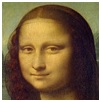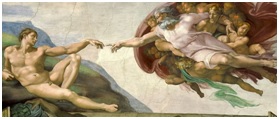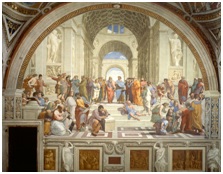|
 |
|
 |
|
|
||
The Renaissance - Learning and Creativity
The Renaissance (15th & early 16th centuries)
Famous for... An explosion of intellectual and creative activity in Europe in the fifteenth and early sixteenth centuries (renaissance is a French word meaning re-birth).
Why did it happen?
1. Printing Johannes Gutenberg’s (pictured right) invention of the first European printing press in Germany in 1440 accelerated the spread of knowledge. People were particularly inspired by the rediscovery of ancient Greek and Roman art and culture.
2. Patrons of the arts The arts and the great Italian Renaissance cities (Florence, Rome and Venice) were transformed by money from:
3. Wealth and increases in population Europe became richer as businesses prospered, helped by:
4. Bigger markets
Markets increased because:
5. Security The Ottoman (Turkish) empire (led by Suleiman the Magnificent, pictured right above) was a huge
threat to Western Europe after its capture of Budapest in 1521. But Charles V, pictured right, defeated the Turkish siege of Vienna in 1529. The Turkish threat wasn’t completely removed until their defeat at the sea Battle of Leponto in 1571.
Key Renaissance artists
Leonardo da Vinci
(1452-1519) Italian genius - sculptor, architect, engineer and artist His best known paintings are the:
Michelangelo
(1475-1564) Italian sculptor (creator of the nude statue, David), architect and artist Famous for his painting of the ceiling of the Sistine Chapel in Rome - pictured below is God's creation of Adam from the Bible's Book of Genesis.
Raphael (1483-1520)
His paintings include the School of Athens, showing a group of great Greek philosophers, pictured right.
Key Renaissance thinkers Niccolo Machiavelli (1469-1527) - pictured right His book, The Prince (1513) explains that you don’t have to be good to be a great leader. Today’s word ‘Machiavellian’ means using dubious means to get what you want.
Erasmus (1466-1536) - pictured right Dutch scholar and intellectual force behind the Reformation (the Protestant rebellion against the Roman Catholic Church that began in1517). Erasmus proposed a key idea of the Renaissance: humanism (i.e. people can control their lives through their own thought and actions).
Thomas More (1478-1535) - pictured right In his book, Utopia (1516), More (an English friend of Erasmus) wrote about an imaginary and ideal island without intolerance, money or war. He was executed for refusing to support Henry VIII’s divorce.
Nicholas Copernicus (1473-1573) Polish astronomer (pictured right) who proposed that the earth went around the sun (not the other way around as the Roman Catholic Church then believed).
Galileo (1564-1642) Italian scientist and astronomer (pictured right) who was forced by the Roman Catholic Church to publicly withdraw his support for Copernicus in 1633.
Key quotes He who thinks little, errs much, - Leonardo da Vinci (pictured right).
They raise our intellect to heaven, - Michelangelo’s (pictured right) motto referring to painting, sculpture and architecture.
It is surely harmful to souls to make it a heresy to believe what is proved, - Galileo.
|
|
|
||
|
|
||
| Copyright © wisdomtowin.com 2025 All Rights Reserved | ||
|
















